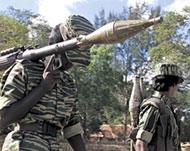Scores die in Sri Lanka bus blast
At least 61 people have been killed in a mine attack on a bus packed with commuters and schoolchildren in Sri Lanka, prompting government air strikes on guerrilla positions.

The government said Tamil Tigers used two mines side by side on an isolated road near Tiger territory. Fifty-eight people died at the scene and three others at hospital, police said.
There was no word on casualties from the air strikes.
The explosion on Thursday – described as huge by military spokesman Brigadier Prasad Samarasinghe – was the worst single act of violence since the government and guerrillas signed a ceasefire in 2002, and renewed fears of a return to war.
Samarasinghe said the dead included children, women and clergy. He added that 45 people were injured.
A doctor at the hospital where the victims’ bodies were taken, SB Bothota, said that 15 children were among those killed.
Tigers blamed
A spokesman for the government’s national security media centre blamed the attack on the Liberation Tigers of Tamil Eelam (LTTE). “Definitely the LTTE. It has to be,” he said.
 |
|
The Tamil Tigers have been |
About 500 people have been killed since early April as talks between the government and Tigers collapsed and many now fear a slide back into the island’s two decade civil war.
The Tigers denied involvement in the attack.
“We have no involvement whatsoever in this killing of innocent civilians,” said head of the Tiger peace secretariat S Puleedevan.
“The Sri Lankan government has a responsibility to investigate law and order in their territory.”
The attackers used a claymore mine, a block of explosives that sends a hail of ball-bearings towards its target, in the north-central province of Anuradapura, police said.
Strategic move
Officials said most of the dead were likely to be from the island’s Sinhalese majority.
Daya Master, media co-ordinator for the Tigers, said the government had launched air raids on northeastern coastal areas of guerrilla territory, the stronghold of their Sea Tigers navy.
|
“Without doubt, this is intended to create a civilian backlash” Palitha Kohona, the head of the government peace secretariat |
The government refused to comment on any retaliation but said they believed the Tigers wanted to spark Sinhalese attacks on ethnic Tamils, driving them into the arms of the guerrillas.
“Without doubt, this is intended to create a civilian backlash,” said Palitha Kohona, the head of the government peace secretariat.
Further north in the town of Vavuniya, near the border with Tiger territory, police said they had found what they suspected was a bomb near a fish market.
Diplomats say neither the government nor the Tigers have shown sufficient flexibility and fear that if violence continues, the country will gradually fall back into a war that has already killed more than 64,000 people.
The Tigers pulled out of peace talks in April but had agreed to talks last week in Oslo over the safety of ceasefire monitors. On arrival, however, they refused to meet the government.
Government spokesman Kehilya Rambukwella said: “We have to seriously consider the ceasefire agreement and possibly restructure it.”